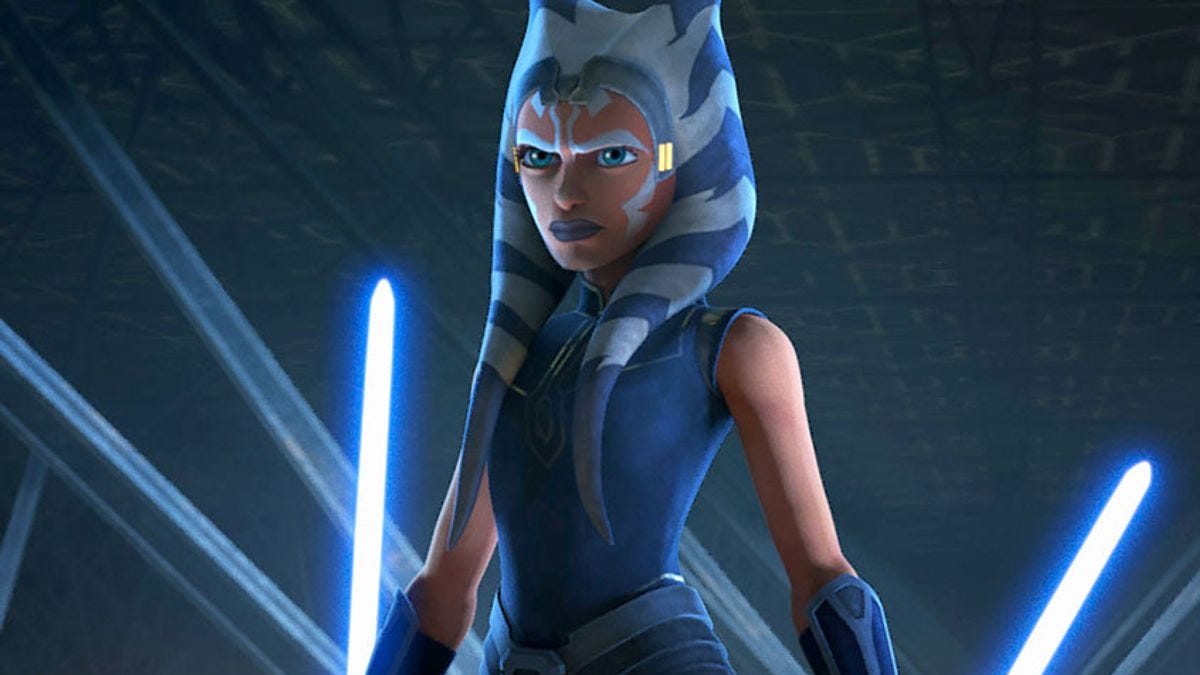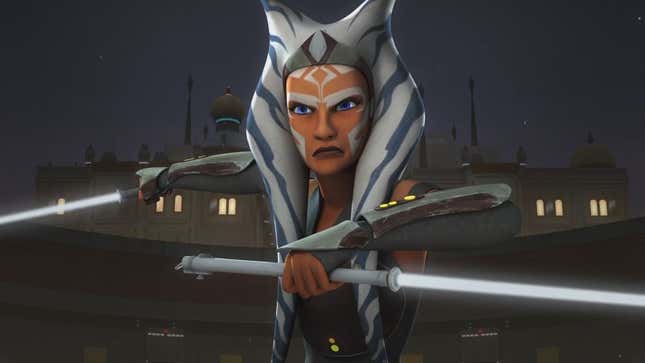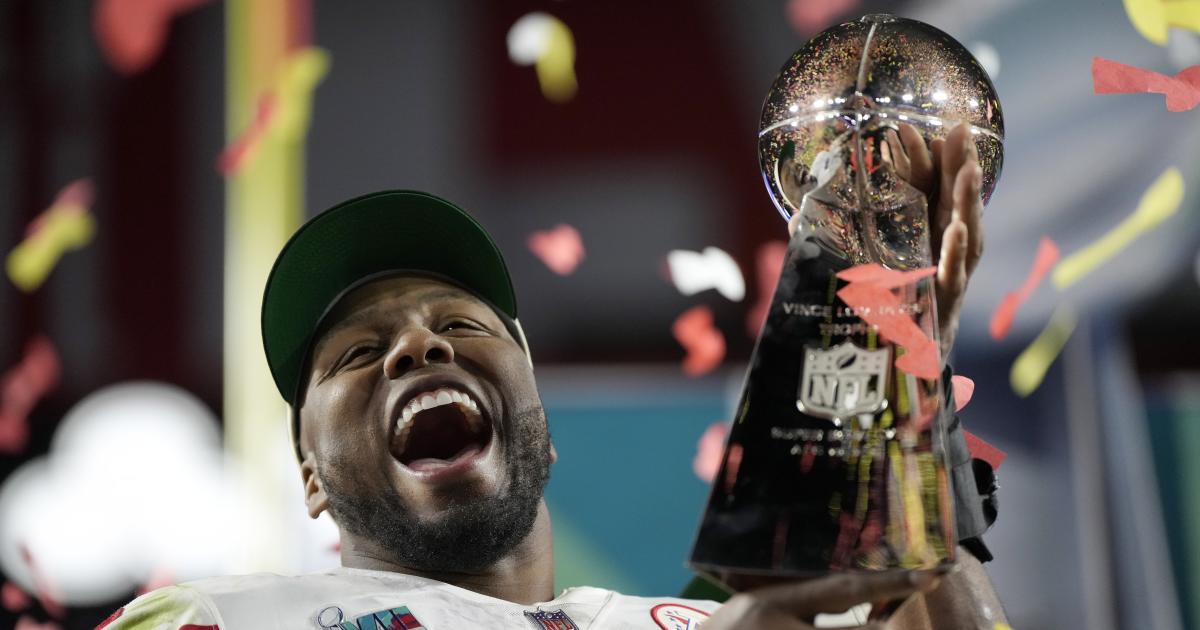
Star Wars is a franchise with a lot of characters, but all of them all feel rooted in a particular place in time. You can feel that the Skywalker twins and Han Solo are products of the late 1970s to some degree or another. Similarly, you can see that someone like Din Djarin or Mace Windu is born out of the late 2010s and early 2000s, respectively. Whether it’s because of the actor’s performance or a character’s writing, there’s just something tactile in the air with much of the players in George Lucas’ sci-fi world.
Ahsoka Tano is… kind of not that. The star of the upcoming live-action Ahsoka Disney+ series (as played by Rosario Dawson) has existed in a weird place for many years, both within the context of Star Wars itself and in the real world. Ahsoka was already in a weird spot when she debuted as a lead character of Cartoon Network’s Star Wars: The Clone Wars (not that one) in 2008, as a previously unmentioned apprentice to Anakin Skywalker. That was already shaky ground to introduce a character who initially seemed to have “I am going to die” written all over her, but that her debut was the deeply mixed Clone Wars movie.
Kid characters in media have always faced an uphill battle with fans, and Star Wars is part of where that ugliness stemmed from. Its fanbase was all too ready and willing to dislike her at best (and at worst, actively root for her death) during those first two seasons, during which she was admittedly a little much in the way that kids often are. Things turned around starting with season three as she aged up, came into her own as a Jedi, and started having more of her own adventures without Anakin and Obi-Wan (or sometimes Plo Koon) there to play the mentor role. Her growth in those later seasons was extremely satisfying to see, which made it all the more gut-wrenching when the Jedi turned on her at the end of season five, resulting in her leaving the Jedi Order entirely. Her existence also let Star Wars fill some niches for a newer audience. She gave Clone Wars watchers a young female lead for girls to project themselves onto, a cool young Jedi who was around the age of the target demographic (and by extension, one could gradually age alongside them), and someone who wasn’t shackled to the either of the then-two trilogies.
Ahsoka’s growth and maturation, and her subsequent popularity, came at the same time that Clone Wars executive producer (and her co-creator) Dave Filoni grew into a key creative figurehead for the franchise. Filoni understandably has a soft spot for the character and has never let her go: she became a guest star in Star Wars Rebels, and was one of the focus points of the first season for last year’s Star Wars: Tales of the Jedi. She’s effectively the face of Star Wars’ animation efforts in the last 15 years, with the Star Wars: Resistance series being the only big-name animated projects she hasn’t shown up in. She’s yet to make an appearance in The Bad Batch, a Clone Wars spinoff, but that could easily change with that show’s third and final season.
But this is where things get kind of weird: to a more casual part of the Star Wars community, Ahsoka is someone they only really met via live-action when she first popped up in 2020 with The Mandalorian’s second season. Years have passed since then, and folks have had time to catch up on her exploits, but that doesn’t change the fact that she’s an anomaly. Over in live-action, the franchise has struggled to maintain the episodic highs that drew folks into The Mandalorian while also organically laying the foundation for the sequel trilogy and Dave Filoni’s movie set in the New Republic. The appearance of Ahsoka hasn’t helped matters—Dawson’s portrayal feels so stark compared to Ahsoka’s voice actor Ashley Eckstein, to the point that they’re basically two separate people, and it’s even more glaring when seeing how the likes of Hayden Christensen, Temeura Morrison, and Katee Sackhoff have successfully been able to bridge their animated and live-action counterparts.
Disney hopes Ahsoka won’t be so impenetrable to newcomers, but that’s basically impossible. By the very nature of the character, and given all she’s touched over her 15-year lifetime, Ahsoka automatically comes with baggage. She’s not Cal Kestis, who’s just getting off the ground, and she’s not Qi’ra, someone who got reworked into a major player for another medium. Ahsoka as a character just can’t be ignored in that same way, and her series is functioning as an extra season to Rebels, a show she was only on for about a sixth of its existence, but which ended by teeing her up as a major player in whatever came next. There’s no escaping her prominence, and treating Ahsoka like it can stand on its own just further highlights how weirdly Disney treats its originally animated characters. Ironically, her existence became infinitely more complicated the moment Filoni decided to bring her along for his jump to a higher position in Lucasfilm—technically new enough of a character to be exciting while also having enough history to make her stand up there with some of the best Star Wars characters.

So much of the marketing for Ahsoka has a made a point to highlight what she is in the context of the universe. In the real world, she’s a bit of a mess, and a unique one at that. There’ve been other characters with a similar “who is this??” aura carried over from different mediums like Darth Maul, but they haven’t been afforded the chance to get their star power boosted like Ahsoka has. And it’s up to the show to finally thread that in a way that makes her feel like she’s becoming whole rather than being so disjointed.
Ahsoka premieres August 23 on Disney+.
Want more io9 news? Check out when to expect the latest Marvel, Star Wars, and Star Trek releases, what’s next for the DC Universe on film and TV, and everything you need to know about the future of Doctor Who.





